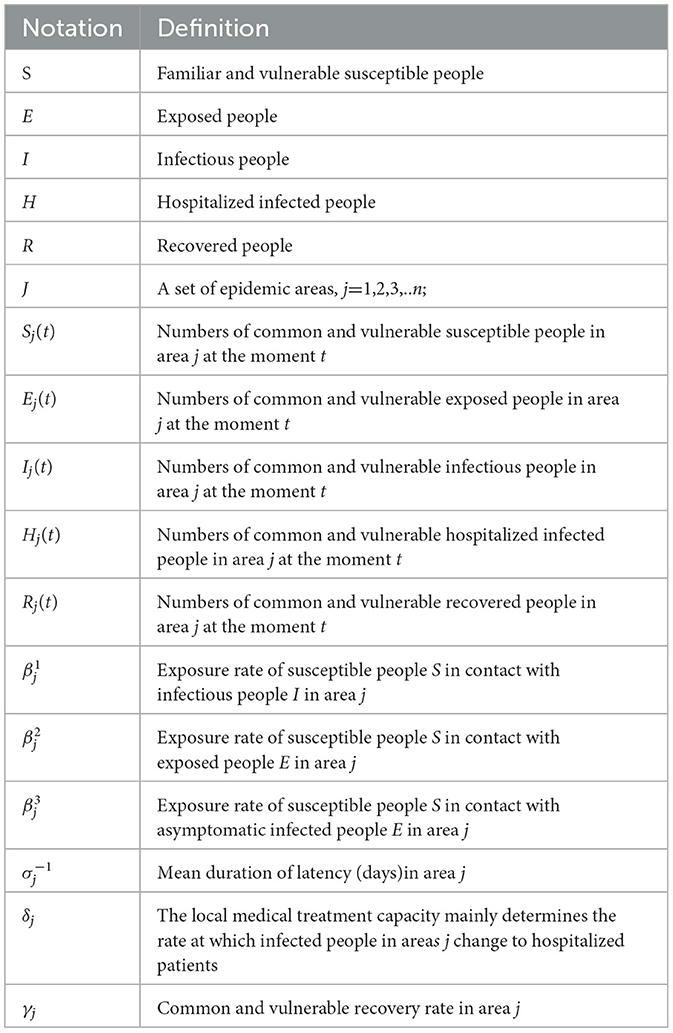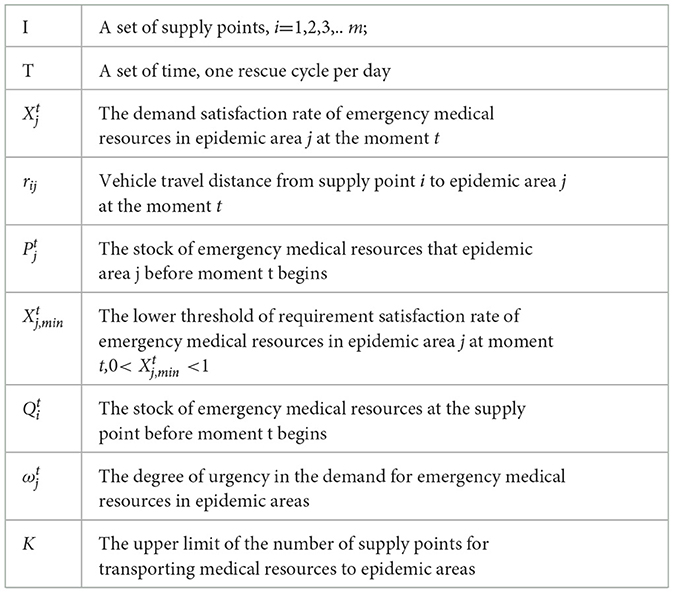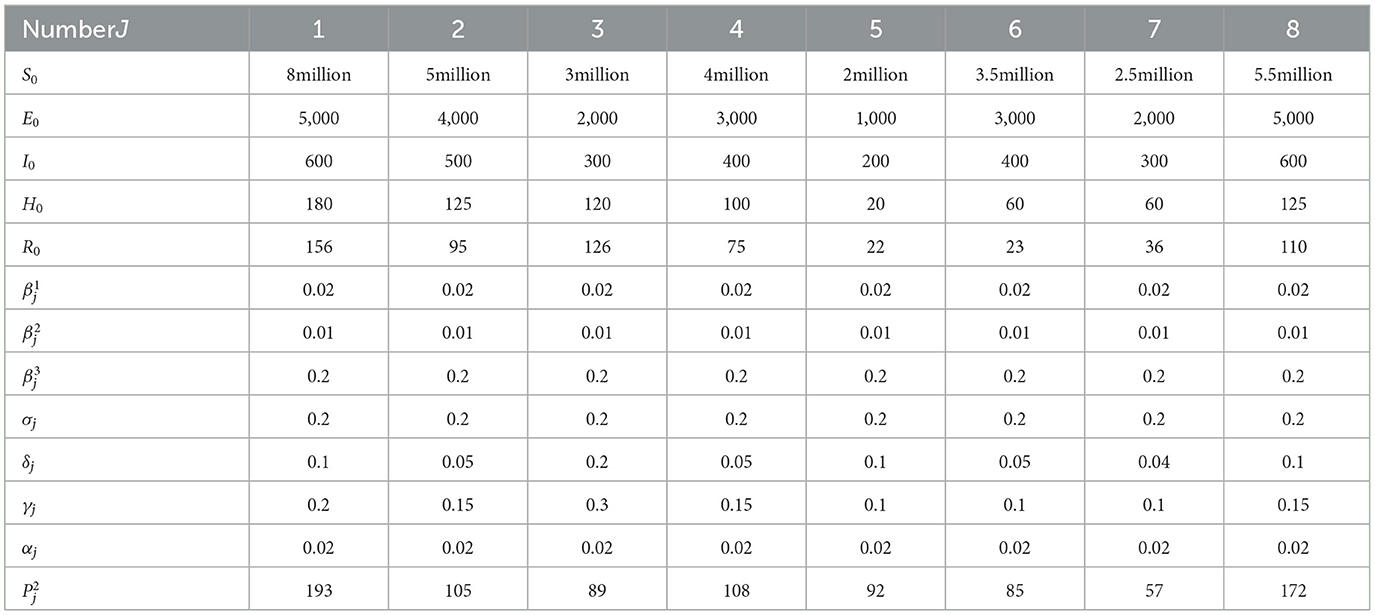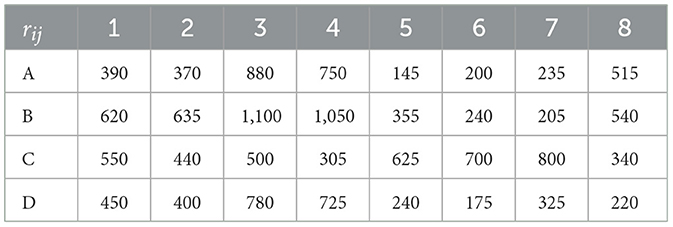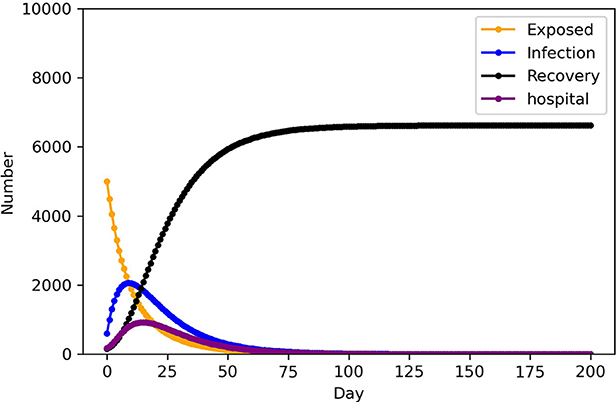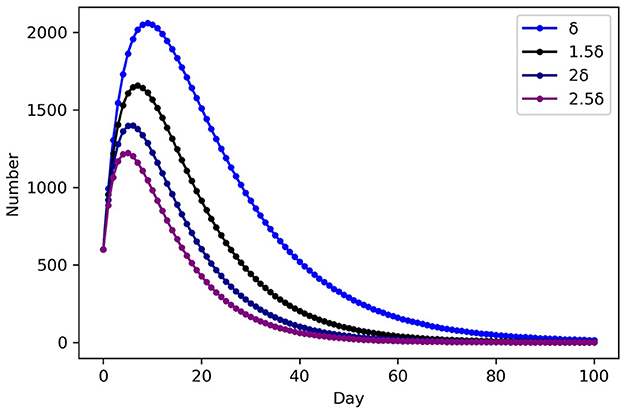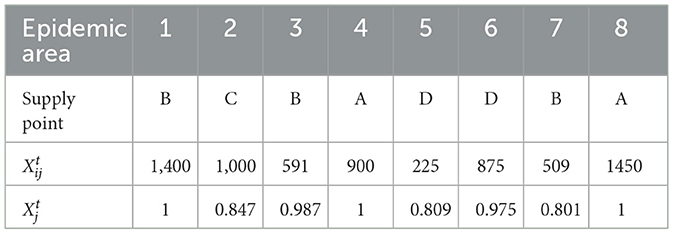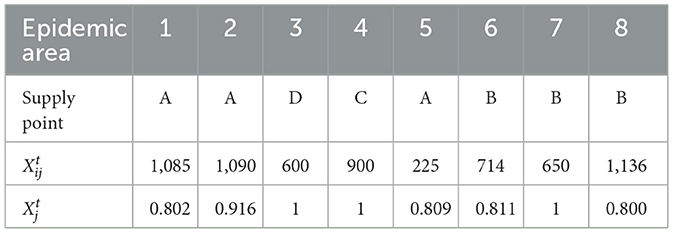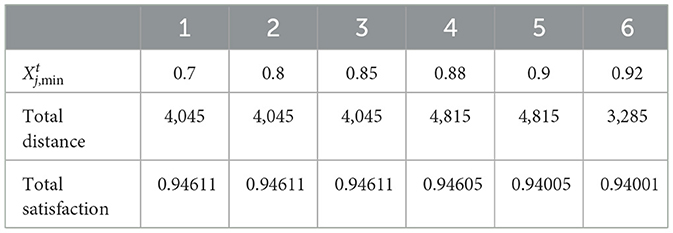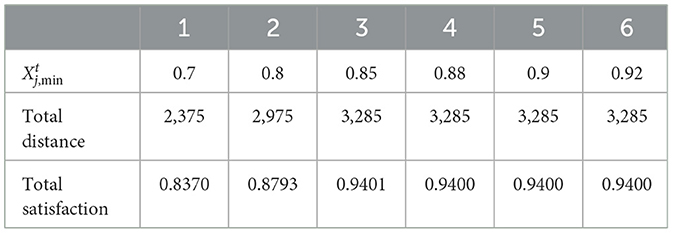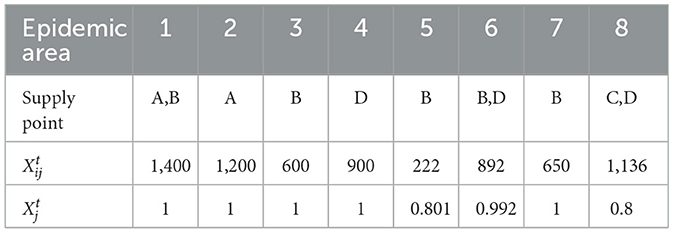- 1School of Public Health, Xuzhou Medical University, Xuzhou, China
- 2School of Management, Xuzhou Medical University, Xuzhou, China
- 3Department of Logistics and Supply Chain Management School of Business, Singapore University of Social Science, Singapore, Singapore
- 4Affiliated Hospital of Xuzhou Medical University, Xuzhou, China
Background: The resources available to fight an epidemic are typically limited, and the time and effort required to control it grow as the start date of the containment effort are delayed. When the population is afflicted in various regions, scheduling a fair and acceptable distribution of limited available resources stored in multiple emergency resource centers to each epidemic area has become a serious problem that requires immediate resolution.
Methods: This study presents an emergency medical logistics model for rapid response to public health emergencies. The proposed methodology consists of two recursive mechanisms: (1) time-varying forecasting of medical resources and (2) emergency medical resource allocation. Considering the epidemic's features and the heterogeneity of existing medical treatment capabilities in different epidemic areas, we provide the modified susceptible-exposed-infected-recovered (SEIR) model to predict the early stage emergency medical resource demand for epidemics. Then we define emergency indicators for each epidemic area based on this. By maximizing the weighted demand satisfaction rate and minimizing the total vehicle travel distance, we develop a bi-objective optimization model to determine the optimal medical resource allocation plan.
Results: Decision-makers should assign appropriate values to parameters at various stages of the emergency process based on the actual situation, to ensure that the results obtained are feasible and effective. It is necessary to set up an appropriate number of supply points in the epidemic emergency medical logistics supply to effectively reduce rescue costs and improve the level of emergency services.
Conclusions: Overall, this work provides managerial insights to improve decisions made on medical distribution as per demand forecasting for quick response to public health emergencies.
1. Introduction
Since the turn of the twenty-first century, there have been numerous outbreaks of large-scale infectious diseases throughout the world. An epidemic occurs when an infectious disease spreads quickly and affects a significant number of individuals. Epidemic infections can spread widely in a short period, usually within 2 weeks or less (1). The most dangerous epidemics include SARS (2003), H1N1 influenza (2009), Middle East Respiratory Syndrome (2012), Ebola virus in West Africa (2014), Zika virus in Brazil (2015), and the continuing COVID-19, which broke out in late 2019 and rapidly became a pandemic, affecting the lives of millions at a global scale. With the emergence of the Novel Coronavirus variant, the number of new coronavirus cases in the world remains high every day. According to the latest real-time statistics from the WHO, as of 17:34 am Central European Time on December 1 (0:34 am Beijing time on December 2), the cumulative number of confirmed COVID-19 cases in the world has reached 63,957,2,819, with 6,615,258 cumulative deaths. These outbreaks pose a major threat to human physical and mental health, as well as to world economic progress.
Emergency medical logistics in response to public health emergencies is very important, but the research in this area is still inadequate (2). This work reviews the related literature by first focusing on prediction of the number of infected person infectious diseases and then discussing the approaches to logistics distribution for an emergency.
The use of the mathematical model to analyze the kinetic behavior of diseases dates back to Daniel Bernoulli's (3) 1760 research on the inoculation of smallpox infectious disease, which is known as the Bernoulli equation. Enko et al. (4) developed the discrete infectious disease model based on the binomial distribution for the first time by collecting the data on scarlet fever and measles and published the chain binomial model of scarlet fever and measles in 1889. The twentieth century saw the emergence of deterministic research on infectious illness models. Hamer (5) developed the dynamic measles model of herd immunity, which is a discrete state model with a bilinear infection rate. For the first time, a mass effect was proposed in the model, and it was assumed that the effective infection rate of individuals was proportional to the number of susceptible individuals. Ross (6) developed a differential equation model for the first time through the study of malaria transmission rules, demonstrating that malaria transmission could be controlled when the number of mosquitoes was reduced to a certain threshold and defined the standard infection rate and basic regeneration number. Kermack et al. (7) established a susceptible -infected-recovered (SIR) model after jointly studying the transmission trend of the Black Death in London, England, in 1665 and the plague in Mumbai, India, in 1906. Subsequently, the susceptible-infected-susceptible model was established in 1932 (8). Samsuzzoha et al. (9) established a susceptible-vaccinated-exposed-infected-recovered (SVEIRS) model, a diffuse zonal epidemic model of vaccination based on the SEIRS model, to investigate the impact of vaccination and transmission dynamics of influenza epidemics. Chinazzi et al. (10) predicted the influence of travel restrictions on the domestic and international transmission of an epidemic disease using a global congregational disease transmission model, and they find the quarantine in Wuhan slowed the overall progress of the epidemic in mainland China by 3–5 days and had a more significant impact on the international scale. Jumpen et al. (11–13) established a susceptible-exposed-infected-quarantined-recovered (SEIQR) model to simulate the evolution of the epidemic from the perspective of patient isolation, and used sensitivity analysis to investigate the impact of parameter uncertainty on the prediction of disease transmission. Yang et al. (14) updated the SEIR model to account for population flow and used deep learning methods to properly forecast the spread of an outbreak in China. Jia et al. (15) projected the relative frequency and geographical distribution of new coronavirus type 2 infection in mainland China before February 19, 2020, using the Wuhan population distribution. The publication of these scientific study findings established a highly effective theoretical and practical foundation for the efficient execution of epidemic prevention and control. Primarily, most scholars studied the laws of the epidemic disease transmission from two perspectives: the evolution of the outbreak population and the effect of related parameters on the development of the outbreak. They used the related mathematical theory and methods to prove the stability of the epidemic spread model, basic reproductive number, and threshold value for the existence of equilibrium of the model itself. These mathematical models can be used to describe the dynamic changes associated with various diseases and to forecast outbreak demand. In this paper, the system dynamics model is used to study the law of epidemic disease transmission.
For the dispatching and distribution of emergency supplies problem, scholars have established optimization models for allocating emergency materials in the event of a public health emergency, such as an outbreak of infectious diseases (16–26). Some of these scholars overlooked the impact of the evolution of infectious disease epidemics on supplies (16–21). Miniguano-Trujillo et al. (27) developed a multi-periodic integer programming optimization model and heuristic algorithm for allocating appropriate time to therapists for various patient types. A mixed-integer linear programming (MILP) model was established to achieve equity. Numerical results showed that treatment resources allocation based on population ratio is suboptimal. Implementing such a resource allocation policy may decrease the total number of infections and deaths, resulting in high costs that must be paid for equity. Repoussis et al. (28, 29) developed the optimal allocation of emergency medical resources in mass casualty events. Because it is critical to prioritize the allocation of emergency medical resources, the author turned the triage problem with limited resources into an ambulance route problem model to determine patients' evacuation sequence and destination hospital. To address the problem and find the optimal solution, an algorithm based on the column generation method was proposed. Pu (30) proposed a MILP model to tackle the allocation of patients to hospitals and treatment sequencing difficulties in mass casualty incidents, intending to effectively allocate limited resources in the response phase. Simultaneously, the model was built to minimize the total response time and flow time needed to treat all patients, and it was solved using precise and MILP-based heuristics. Ray (31) developed a model for emergency relief material transportation under various constraints to optimize transportation expenses. In general, current research results indicate that, within the context of public health emergency studies, emergency logistics management is a significant research topic, and its study has profound theoretical and practical implications, demonstrating the necessity and importance of emergency logistics management. Additionally, it contributes significantly to the reduction of fatalities and property damage caused by emergencies. However, most studies (32, 33) focus on the one-time distribution of supplies and dispatch of emergency supplies, and rarely consider the emergency in epidemic areas, dynamic distribution of supplies, or actual situations in which different local medical treatment capabilities exist against the background of an epidemic and resulting in varying influences on the epidemic transmission evolution trend. After the outbreak of infectious diseases, the epidemic degree varies by epidemic location, and the demand for supplies in the epidemic area is determined by the number of confirmed infections.
The primary objective of this study is to quantify the actual situation in the epidemic area to distribute supplies, and help decision-maker to make best choices on the allocation of limited emergency medical resources to the appropriate places and quantities to halt the outbreak and mitigate its effects.
To be specific, this paper is based on human data collected in each of the affected areas. A particular point in time in the historical data is selected as the basis point. The personnel situation in each epidemic area at the decision time is forecasted based on the information at the basis point using the modified infectious disease model. The number of infected and hospitalized groups is simulated in each area to forecast patients' demand for emergency medical resources. Under the assumption that the demand for emergency medical resources for patients with infectious diseases and inpatients is known, we define emergency indicators for each epidemic area and develop a bi-objective optimization model to determine the optimal medical service allocation plan by maximizing the weighted demand satisfaction rate and minimizing the total vehicle travel distance.
In summary, this paper takes sudden infectious public events as the background, emphasizes emergency logistics schedule optimization, and presents an emergency rescue logistics model based on infectious diseases transmission mechanism. First, based on the transmission rules of infectious diseases combined with the local medical treatment capability, the modified susceptible-exposed-infected-recovered (SEIR) model are proposed to predict the material demand of each epidemic area during the entire emergency rescue stage. Second, a mixed-integer programming model for multi-stage and multi-cycle emergency rescue logistics scheduling in multi-epidemic areas is built with fairness (34) and timeliness in mind, and the route selection of rescue vehicles and allocation of medical resources are optimized. Finally, using the linear weighting and ε-constraint method, the MILP model of multi-objective emergency rescue logistics scheduling is transformed into a single-objective model, and LINGO software and YALMIP toolbox MATLAB program are used to validate the numerical examples.
2. Methods
2.1. Model assumptions
(1) The local population is relatively steady, regardless of migration, natural birth rate, or death rate.
(2) The infected individual requires pharmacological therapy following hospitalization.
(3) Individuals who have recovered get permanent immunity.
(4) It is assumed that the functional relationship between the demand for emergency medical resources and the number of infected individuals in the epidemic area is known.
(5) It is assumed that the demand for supplies in the epidemic area and reserves of relief centers can be forecasted, as well as the number of and geographic location of epidemic areas.
(6) This paper does not consider the number of vehicles, transportation mode, transportation capacity limits, or other related factors while implementing quarantine policies during an epidemic.
2.2. The time-varying demand forecasting model
According to the unique characteristics of the spread of infectious diseases, the precise allocation of emergency supplies during an epidemic can be summarized as follows: (1) During the early stages of an epidemic, it is necessary to quantify the extent of the emergency in epidemic areas. The epidemic locations are diverse, and each area has a unique crisis circumstance. (2) Because supplies demand are highly correlated with the number of confirmed infections, it is vital to forecast the demand in the epidemic area based on the number of infected people.
Based on the characteristics of the initial spread of infectious disease, hence the SEIHR warehouse models are created. We categorize the affected area's population into six subgroups: susceptible (S), exposed (E), infective (I) who have developed symptoms following the incubation period but have not been hospitalized or isolated, hospitalized infected (H), and recovered (R). N = S + E + I + H + R is used to calculate the total population in each epidemic area. Figure 1 shows the transfer of this model between these epidemic classes. Table 1 shows the definitions of the time-varying forecasting of the medical resources model.
The susceptible population (S) reduce as a result of exposure to exposed, infected, and asymptomatic infected people, and they will enter the incubation period of exposure (moving to class E). As shown in formula 1.
The exposed population (E) become infected (moving to class I) with evident symptoms. As shown in formula 2.
The infected population (I) enter the inpatient stage (moving to class H) according to the local medical treatment capability. As shown in formula 3.
After treatment, the hospitalized population (H) reduces and enter the recovery population (moving to class R). As shown in formula 4.
The recovery population is immune to this disease.
2.3. SEIHR model
2.4. Emergency medical resource distribution decision model
Mixed-integer linear programming (MILP) is used to develop a deterministic resource allocation model. Table 2 shows the definitions of the Emergency medical resource distribution decision model.
2.4.1. Notation
2.4.2. Decision variables
Based on the descriptions and assumptions of the abovementioned models, the following multi-objective emergency relief supply distribution decision model can be established for each time cycle, to maximize the weighted sum of the demand satisfaction rates and minimize travel distance:
: The quantity of emergency medical resources allocated from supply point i to epidemic area j at the moment t
: 0–1 variable: if emergency medical resources are delivered from supply point i to epidemic area j at the moment t, it is 1; otherwise, it is 0.
2.4.3. Objective function
Objective 1: To maximize the weighted sum of demand satisfaction rates for each period.
Objective 2: To minimize the sum of driving distances per period.
2.4.4. Constraints
Subject to
Constraint (9) is the formula for calculating the demand satisfaction rate. When the supply exceeds the demand, the demand satisfaction rate should be equal to one.
Constraint (10) establishes a minimal demand satisfaction rate for all epidemic areas, which reflects the fairness principle.
According to constraint (11), the quantity of emergency medical resources delivered from the central distribution center shall not exceed its stock.
Constraint (12) indicates the relationship between these two variables, that is, only when the quantity of goods dispatched from the supply point to the epidemic area is not equal to 0, then the is equal to 1.
The purpose of constraint (13) is to prevent the supply point from receiving more materials than required.
Constraint (14) demonstrates that one epidemic area can only be served by K supply point to prevent wasting of transport capacity.
Constraints (15) and (16) are constraints on variable values.
2.5. Model solution
The key to solving multi-objective (35–38) problems is to convert the multi-objective function into a single-objective programming problem using the weighted method, constraint method, and mixed-method, which is solved using the traditional single-objective programming method. The ε-constraint method is an exact approach that is capable of generating non-extreme efficient solutions. An ε-constraint method also performs well in mixed-integer multi-objective problems.
In this paper, the multi-objective problem is standardized using min-max first, and then the maximization objective function is converted into the minimization objective.
2.5.1. ε-Constraint method
An ε-constraint method is a well-known approach used for solving multi-objective problems. This method is to convert a multi-objective problem into a single-objective problem, where only one objective is optimized and the remaining objectives are treated as constraints. The general form of this algorithm is defined by Eq. (18), where X denotes the feasible set of the mathematical model:
2.5.2. Weighting sum method
Weighted sum method is the most frequently used technique to evaluate efficient solutions for a deterministic multi-objective optimization problem. The multi-objective problem is converted into a single-objective problem using the linear weighted grouping method, and assigning a weight to each sub-objective based on its importance. The overall objective function is:
According to Formula (16), when the supply of emergency medical resources is sufficient to fulfill demand, the first term on the right end has a constant value of 1. In this case, the model is simplified as the optimization model to minimize the total driving distance. When the supply of medical resources for all points does not exceed the demand, the optimization model is reformulated into a MILP problem.
Constraint (9) is transformed into:
2.6. Numerical experiments
2.6.1. Base case
Suppose that eight epidemic areas (numbered 1, 2, 3, 4, 5, 6, 7, 8) require immediate assistance as a result of the emergence of the epidemic. Four supply points (numbered A, B, C, and D) can provide emergency medical resources for the epidemic areas, with storage of A = 2,400, B = 2,500, C = 1000, and D = 1100, respectively. One supply point can only supply one epidemic area. Because the propagation of the epidemic differs from other situations and has an infectious time, it is difficult to determine the exact start date of the crisis. As a result, a date in the past is chosen as the start time. Different epidemic areas' start time information is shown in Table 3. Distances (in units/km) between the eight epidemic areas and the four supply points are shown in Table 4.
2.6.2. Experiments on the base case
The sensitivity analysis of the calculation results is conducted below, and the effect of adjusting the minimum demand satisfaction rates in the model is studied. When we change the number of supply points in an epidemic area, the results are also different.
3. Results
3.1. Base case
As indicated in Table 5, the SEIHR model is used to calculate the number of infected people, level of emergency, and total medical demand in each epidemic area after 2 days, Figure 2 show the variation in population numbers over time in epidemic area 1. Medical and health intervention is manifested by the level of medical treatment when infectious diseases occur, whether the medical resources are sufficient and complete, and whether all the patients can be collected when the number of infected patients increases rapidly, so that the patients can get timely and effective treatment. To improve the ability to treat patients can be regarded as the rate at which infected people in areas j change to hospitalized patients of infectious disease model. δ = (δ, 1.5δ, 2δ, 2.5δ), to analyze the impact on the number of infected people. Control variable method was adopted, remaining parameters remained unchanged, and SEIHR model was used to simulate the development of infected persons in Region 1, as shown in Figure 3.
The trend of the number of each population in the infectious disease model over time can be calculated, by using PYTHON programming to enter the parameters in Table 3 into the models. As illustrated in Figure 2, the number of infected and hospitalized patients grows over time and declines following adequate treatment, while the number of recovered patients increases throughout the whole stage. This result is consistent with the transmission mechanism of infectious diseases. From Figure 3, As medical and health care intervention gradually increases, δ of the corresponding model increases, the peak time of infection moved forward and the peak number of infected persons decreases accordingly. An adequate supply of medical resources is therefore critical to ending the outbreak quickly. In addition, early action on non-drug interventions are critical to epidemic control, and the lessons learned from epidemic control by WHO also show that early action will make significant progress in slowing and ultimately stopping outbreaks (39).
The model is programmed and the computation results are verified using the LINGO software and MATLAB YALMIP toolbox. When fairness is the main objective, the results of the ε-constraint method are shown in in Table 6: .
When the fairness and efficiency weights were 0.5, the results of the weighting sum method are shown in Table 7: .
Generally speaking, the proposed dispatching and distribution model can satisfy the demand in each epidemic area to the greatest extent, meanwhile ensuring a fair allocation of materials among all the areas. Supplies will be delivered to each area from the nearest distribution center. Decision-makers can choose either objective based on their evaluations. The dual objective mixed-integer programming model, which takes into account both fairness and efficiency of the allocation of medical resources, also provides decision-makers flexibility to choose either objective based on their evaluations. Therefore, this work provides management insights for improving medical delivery decisions based on demand projections to rapidly respond to public health emergencies.
3.2. Experiments on the base case
3.2.1. Effect of the lowest satisfaction rate
This section primarily examines the effect of the difference in the minimum satisfaction rate of all epidemic areas on corresponding decisions, and the results of the ε-constraint method are presented in Table 8 and Figure 4.
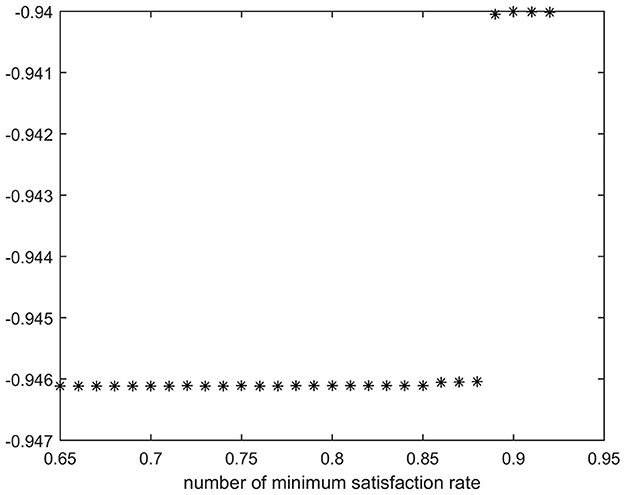
Figure 4. Impact of different minimum satisfaction rates on emergency rescue targets of the ε-constraint method.
The black dots in Figure 4 represent the value of objective function 1 at various levels of minimum satisfaction.
The results reveal that the value of the first objective function increases as the minimum satisfaction rate increases. Thus, the maximization of the weighted sum of the demand satisfaction rates shows a declining trend. This corresponds to the actual situation.
When the fairness and efficiency weights are 0.5, the results of the weighting sum method are shown in Table 9 and Figure 5.
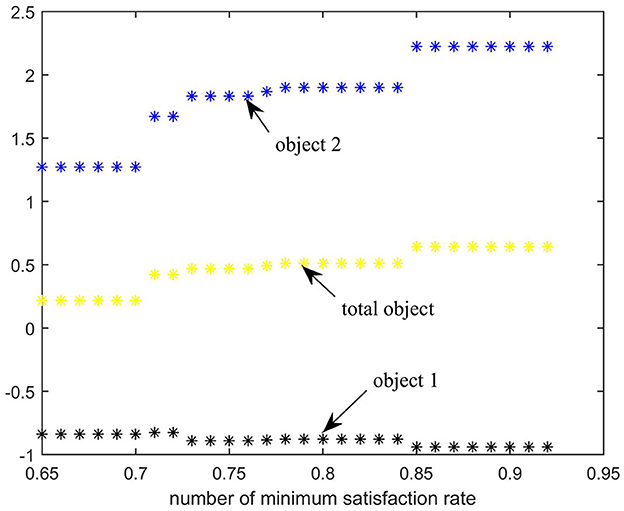
Figure 5. Impact of different minimum satisfaction rates on emergency rescue targets of the Weighting sum method.
The black dots (object 1), blue dots (object 2), and yellow dots (total object) represent the values of objective 1, the normalized objective 2, and the weighted value of the total objective at various minimum satisfaction rates, respectively.
As shown in Figure 5, when the fairness and efficiency weights are set to 0.5, the total weighted satisfaction rate and vehicle travel distance in the epidemic area increase with the increment of the minimum satisfaction rate.
The value of the minimum demand satisfaction rate is extremely important, and decision-makers should assign appropriate values to parameters at various stages of the emergency process based on the actual situation, to ensure that the results obtained are feasible and effective.
3.2.2. Effect of multiple supply points in an infected area
This section focuses on the influence of the different numbers of supply points on relevant decision-making in all epidemic areas where . When K (The upper limit of the number of supply points for transporting medical resources to epidemic areas) = 2, the satisfaction rate of each epidemic area is shown in Table 10.
When K = 2, the weighted sum of the demand satisfaction rate is 0.9522, which is greater than when K = 1. When K = 2, the total travel distance is 4740 km, which is larger than the total travel distance of 4,045 km when K = 1. This trend is in line with common sense. Furthermore, when K = 3, the decision result is the same as when K = 2. Thus, even while the overall weighted satisfaction of residents in the epidemic area increases when supplies are delivered from two supply points, it happens that each supply point may deliver a small number of supplies, resulting in a waste of transportation resources. Therefore, for decision-makers, it is necessary to set up an appropriate number of supply points in the epidemic emergency medical logistics supply to effectively reduce rescue costs and improve the level of emergency services.
4. Conclusion
In comparison to traditional emergency logistics, emergency medical logistics (40) has three characteristics that raise the complexity and difficulty of solving logistical problems. To begin with, there is a dearth of demand-related information, such as the severity of the epidemic and the number of infected, as well as difficulties in marking distribution-related decisions. The incubation phase, in particular, results in a time delay in demand (41). Second, the disease can quickly spread from one location to another, resulting in a large-scale epidemic. Infection, recovery, and mortality rates typically vary across regions due to differences in individual physical conditions as well as habits, customs, and medical services provided by the hospitals in each region (42, 43). Third, unlike other forms of relief such as food, the substitutability of medical relief is imperfect. Specific medication cannot be completely replaced by another (44). This paper discusses how to allocate emergency supplies under two different infectious disease propagation scenarios. Specifically, this work contributes to the decision analysis of emergency medical logistics responses to public health emergencies in the following ways: First, based on the transmission rules of infectious diseases and local medical service capacity, we modify and develop a SEIHR (susceptible-exposed-infected-hospitalized-removed) model. These two models aim to forecast the time-varying demand for medical supplies in each epidemic area during the entire emergency rescue phase. Second, to find the optimal medical service allocation plan, we define emergency indicators for each epidemic area and propose a bi-objective optimization model to maximize the weighted demand satisfaction rate and minimize the total vehicle travel distance. Finally, we use linear weighting and the ε-constraint method to reformulate the bi-objective MILP model of emergency rescue logistics scheduling to a single-objective one. We also conduct numerical studies to examine the performance of the model.
4.1. Implications
Numerical results show that due to the hidden nature of asymptomatic infection, the number of infected people in infected areas will increase greatly. Decision-makers should assign appropriate values to parameters at various stages of the emergency process based on the actual situation, to ensure that the results obtained are feasible and effective. It is necessary to set up an appropriate number of supply points in the epidemic emergency medical logistics supply to effectively reduce rescue costs and improve the level of emergency services. Overall, this work provides managerial insights to improve decisions made on medical distribution as per demand forecasting for quick response to public health emergencies.
4.2. Limitations
Our study is hypothetical, without actual data. This study only evaluates how to predict the demand for medical aid resources and how to allocate resources based on the number of infected and hospitalized people in the epidemic areas. The supply points have also been fixed for the time being; however, these supply points can be adjusted continuously according to the number of supplies, location advantages, and the number of individuals serving in the epidemic area. Furthermore, the impact of population mobility and natural population growth rate on the spread of the epidemic is not considered in this work. Finally, the paper ignores the impact of material production capacity on decision-making.
In conclusion, the performance of emergency medical logistics may be improved significantly. Future research can take the material production supply chain, dynamic resource allocation based on locations of supplies, vehicle scheduling, and vehicle routing optimization problem into consideration. These factors help to establish a model that is more in line with the reality in medical resource allocation, thus more scientific and reasonable to solve practical problems.
Data availability statement
The original contributions presented in the study are included in the article/supplementary material, further inquiries can be directed to the corresponding author.
Author contributions
ZW: supervision. GJ: formal analysis, methodology, validation, and writing – original draft. XY, WC, and TY: visualization. QZ: writing – review and editing. BH: funding acquisition. All authors contributed to the article and approved the submitted version.
Funding
This work was supported by the Ministry of Humanities and Social Science Education Project (No. 19YJC630182), Science and Technology Program Project of Xuzhou (No. KC20200), Postgraduate Research and Practice Innovation Program of Jiangsu Province ( No. KYCX21_2636), Postgraduate Research and Practice Innovation Program of Jiangsu Province (No. SJCX21_1157), Postgraduate Research and Practice Innovation Program of Jiangsu Province (No. SJCX22_1291), and Scientific Research Foundation for Excellent Talents of Xuzhou Medical University (No. D2019004).
Conflict of interest
The authors declare that the research was conducted in the absence of any commercial or financial relationships that could be construed as a potential conflict of interest.
Publisher's note
All claims expressed in this article are solely those of the authors and do not necessarily represent those of their affiliated organizations, or those of the publisher, the editors and the reviewers. Any product that may be evaluated in this article, or claim that may be made by its manufacturer, is not guaranteed or endorsed by the publisher.
References
1. Yin X, Buyuktahtakin IEA. multi-stage stochastic programming approach to epidemic resource allocation with equity considerations. Health Care Manag Sci. (2021) 24:597–622. doi: 10.1007/s10729-021-09559-z
2. Hu ZH, Sheu JB, Xiao L. Post-disaster evacuation and temporary resettlement considering panic and panic spread. Trans Res Methodol. (2014) 69:112–32. doi: 10.1016/j.trb.2014.08.004
3. Dietz K, Heesterbeek JAP. Daniel Bernoulli's epidemiological model revisited. Math Biosci. (2002) 180:1–21. doi: 10.1016/S0025-5564(02)00122-0
4. Enko PD. On the course of epidemics of some infectious diseases. Int J Epidemiol. (1989) 18:749–55. doi: 10.1093/ije/18.4.749
5. Hamer WH. Epidemic Disease in England: The Evidence of Variability and of Persistency of Type. Lambertville, MI: Bedford Press (1906).
7. Kermack WO, McKendrick AGA. contribution to the mathematical theory of epidemics. Proc Royal Soc Containing Mathematic Phys Character. (1927) 115:700–21. doi: 10.1098/rspa.1927.0118
8. Kermack WO, McKendrick AG. Contributions to the mathematical theory of epidemics. II—the problem of endemicity proceedings of the Royal Society of London Series A, containing papers of a mathematical and physical character. Royal Soc. (1932) 138:55–83. doi: 10.1098/rspa.1932.0171
9. Samsuzzoha M, Singh M, Lucy DA. Numerical study on an influenza epidemic model with vaccination and diffusion. Appl Mathematics Comput. (2012) 219:122–41.· doi: 10.1016/j.amc.2012.04.089
10. Chinazzi M, Davis JT, Ajelli M, Gioannini C, Litvinova M, Merler S, et al. The effect of travel restrictions on the spread of the 2019 novel coronavirus (COVID-19) outbreak. Science. (2020) 368:395–400.· doi: 10.1126/science.aba9757
11. Jumpen W, Wiwatanapataphee B, Wu Y, Tang IAASE. IQR model for pandemic influenza and its parameter identification. Int J Pure Appl Mathematics. (2009) 52:247–65.
12. Fazio RH, Ruisch BC, Moore CA, Samayoa JAG, Boggs ST, Ladanyi JT, et al. Social distancing decreases an individual's likelihood of contracting COVID-19. Proc Nat Acad Sci. (2021) 118:8. doi: 10.1073/pnas.2023131118
13. Hou C, Chen J, Zhou Y, Hua L, Yuan J, He S, et al. The effectiveness of quarantine of Wuhan city against the corona virus disease 2019 (COVID-19): A well-mixed SEIR model analysis. J Med Virol. (2020) 92:841–8.· doi: 10.1002/jmv.25827
14. Yang Z, Zeng Z, Wang K, Wong SS, Liang W, Zanin M, et al. Modified SEIR and AI prediction of the epidemics trend of COVID-19 in China under public health interventions. J Thorac Dis. (2020) 12:165–74.· doi: 10.21037/jtd.2020.02.64
15. Jia JS, Lu X, Yuan Y, Xu G, Jia J, Christakis NA, et al. Population flow drives spatio-temporal distribution of COVID-19 in China. Nature. (2020) 582:389–94.· doi: 10.1038/s41586-020-2284-y
16. Ordu M, Demir E, Tofallis CA. comprehensive modelling framework to forecast the demand for all hospital services. Int J Health Plann Manage. (2019) 34:e1257–71. doi: 10.1002/hpm.2771
17. Remuzzi A, Remuzzi G. COVID-19 and Italy: what next? Lancet. (2020) 395:1225–8. doi: 10.1016/S0140-6736(20)30627-9
18. Verhagen MD, Brazel DM, Dowd JB, Kashnitsky I, Mills MC. Forecasting spatial, socioeconomic and demographic variation in COVID-19 health care demand in England and Wales. BMC Med. (2020) 18:203.· doi: 10.1186/s12916-020-01646-2
19. Weissman GE, Crane-Droesch A, Chivers C, Luong T, Hanish A, Levy MZ, et al. Locally informed simulation to predict hospital capacity needs during the COVID-19 pandemic. Ann Intern Med. (2020) 173:21–8. doi: 10.7326/M20-1260
20. Rainisch G, Undurraga EA, Chowell GA. Dynamic modeling tool for estimating healthcare demand from the COVID19 epidemic and evaluating population-wide interventions. Int J Infect Dis. (2020) 96:376–83.· doi: 10.1016/j.ijid.2020.05.043
21. He J, Liu G, Mai THT. Research on the allocation of 3D printing emergency supplies in public health emergencies. Front Public Health. (2021) 9:657276.· doi: 10.3389/fpubh.2021.657276
22. Fox GJ, Trauer JM, McBryde E. Modelling the impact of COVID-19 upon intensive care services in New South Wales. Med J Aust. (2020) 212:468. doi: 10.5694/mja2.50606
23. Fanelli D, Piazza F. Analysis and forecast of COVID-19 spreading in China, Italy and France. Chaos Solitons Fractals. (2020) 134:109761. doi: 10.1016/j.chaos.2020.109761
24. Bollon J, Paganini M, Nava CR, De Vita N, Vaschetto R, Ragazzoni L, et al. Predicted effects of stopping COVID-19 lockdown on italian hospital demand. Disaster Med Public Health Prep. (2020) 14:638–42.· doi: 10.1017/dmp.2020.157
25. Nikolopoulos K, Punia S, Schafers A, Tsinopoulos C, Vasilakis C. Forecasting and planning during a pandemic: COVID-19 growth rates, supply chain disruptions, and governmental decisions. Eur J Oper Res. (2021) 290:99–115.· doi: 10.1016/j.ejor.2020.08.001
26. Lam SSW, Pourghaderi AR, Abdullah HR, Nguyen FNHL, Siddiqui FJ, Ansah JP, et al. An agile systems modelling framework for bed resource planning during COVID-19 pandemic in Singapore. Fronti Pub Health. (2022) 10:1179. doi: 10.3389/fpubh.2022.714092
27. Miniguano-Trujillo A, Salazar F, Torres R, Arias P, Sotomayor K. An integer programming model to assign patients based on mental health impact for tele-psychotherapy intervention during the Covid−19 emergency. Health Care Manag Sci. (2021) 24:286–304. doi: 10.1007/s10729-020-09543-z
28. Repoussis PP, Paraskevopoulos DC, Vazacopoulos A, Hupert N. Optimizing emergency preparedness and resource utilization in mass-casualty incidents. Eur J Oper Res. (2016) 255:531–44. doi: 10.1016/j.ejor.2016.05.047
29. Sung I, Lee T. Optimal allocation of emergency medical resources in a mass casualty incident: patient prioritization by column generation. Eur J Oper Res. (2016) 252:623–34. doi: 10.1016/j.ejor.2016.01.028
30. Pu L. Fairness of the distribution of public medical and health resources. Front Public Health. (2021) 9:768728. doi: 10.3389/fpubh.2021.768728
31. Ray JA. A multi-period linear programming model for optimally scheduling the distribution of food-aid in West Africa (Doctoral dissertation, University of Tennessee, Knoxville) (1987):
32. ElDessouki WM. Some Developments in Transportation Network Analysis and Design With Application to Emergency Management Problems. Raleigh, NC: North Carolina State University (1998).
33. Haghani A, Oh SC. Formulation and solution of a multi-commodity, multi-modal network flow model for disaster relief operations. Trans Res Policy Practice. (1996) 30:231–50. doi: 10.1016/0965-8564(95)00020-8
34. Tofighi S, Torabi SA, Mansouri SA. Humanitarian logistics network design under mixed uncertainty. Eur J Oper Res. (2016) 250:239–50. doi: 10.1016/j.ejor.2015.08.059
35. Safaei AS, Farsad S, Paydar MM. Emergency logistics planning under supply risk and demand uncertainty. Operational Res. (2020) 20:1437–60. doi: 10.1007/s12351-018-0376-3
36. Zhang J, Dong M, Chen FFA. bottleneck Steiner tree based multi-objective location model and intelligent optimization of emergency logistics systems. Robot Comput Integr Manuf. (2013) 29:48–55. doi: 10.1016/j.rcim.2012.04.012
37. Zhang J, Liu H, Yu G, Ruan J, Chan FTS. A three-stage and multi-objective stochastic programming model to improve the sustainable rescue ability by considering secondary disasters in emergency logistics. Comput Ind Eng. (2019) 135:1145–54. doi: 10.1016/j.cie.2019.02.003
38. Yuan Y, Wang D. Path selection model and algorithm for emergency logistics management. Comput Ind Eng. (2009) 56:1081–94. doi: 10.1016/j.cie.2008.09.033
39. Jacobsen KH, Aguirre AA, Bailey CL, Baranova AV, Crooks AT, Croitoru A, et al. Lessons from the ebola outbreak: action items for emerging infectious disease preparedness and response. Ecohealth. (2016) 13:200–12.· doi: 10.1007/s10393-016-1100-5
40. He Y, Liu N. Methodology of emergency medical logistics for public health emergencies. Transp Res E Logist Transp Rev. (2015) 79:178–200. doi: 10.1016/j.tre.2015.04.007
41. Zhang J, Ma Z. Global dynamics of an SEIR epidemic model with saturating contact rate. Math Biosci. (2003) 185:15–32. doi: 10.1016/S0025-5564(03)00087-7
42. Brauer F, van den Driessche P. Models for transmission of disease with immigration of infectives. Math Biosci. (2001) 171:143–54. doi: 10.1016/S0025-5564(01)00057-8
43. Capaldi A, Behrend S, Berman B, Smith J, Wright J, Lloyd AL, et al. Parameter estimation and uncertainty quantication for an epidemic model. Mathemati Biosci Eng. (2012) 2012:553. doi: 10.3934/mbe.2012.9.553
Keywords: epidemic diseases, time-varying demand forecasting model, emergency medical resource distribution decision model, resource allocation, ε-constraint method, weighting sum method
Citation: Hu B, Jiang G, Yao X, Chen W, Yue T, Zhao Q and Wen Z (2023) Allocation of emergency medical resources for epidemic diseases considering the heterogeneity of epidemic areas. Front. Public Health 11:992197. doi: 10.3389/fpubh.2023.992197
Received: 12 July 2022; Accepted: 06 February 2023;
Published: 24 February 2023.
Edited by:
Stephen Waller, Uniformed Services University, United StatesReviewed by:
Paolo Di Giamberardino, Sapienza University of Rome, ItalyAnas Khan, King Saud University, Saudi Arabia
Copyright © 2023 Hu, Jiang, Yao, Chen, Yue, Zhao and Wen. This is an open-access article distributed under the terms of the Creative Commons Attribution License (CC BY). The use, distribution or reproduction in other forums is permitted, provided the original author(s) and the copyright owner(s) are credited and that the original publication in this journal is cited, in accordance with accepted academic practice. No use, distribution or reproduction is permitted which does not comply with these terms.
*Correspondence: Zongliang Wen,  d2VuemxAeHpobXUuZWR1LmNu
d2VuemxAeHpobXUuZWR1LmNu
†These authors have contributed equally to this work and share first authorship
 Bin Hu
Bin Hu Guanhua Jiang
Guanhua Jiang Xinyi Yao2
Xinyi Yao2 Wei Chen
Wei Chen Tingyu Yue
Tingyu Yue Qitong Zhao
Qitong Zhao Zongliang Wen
Zongliang Wen
